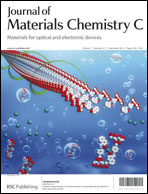All-optical control of localized plasmonic resonance realized by photoalignment of liquid crystals
Abstract
Large shifts in the plasmonic resonances of a thin film of gold nanorods (GNRs) are induced through the modulation of the local refractive index of the neighboring dielectric medium. This change is enabled through light-induced surface reorientation of a nematic liquid crystal in contact with a nanometer-thin photoalignment layer coating the GNR film. The presence of isolated and well distributed GNRs, both before and after the photoalignment layer deposition, is shown through atomic force and scanning electron microscopy. Exposure of the photoalignment layer to polarized light is shown to reorient aligned nematic liquid crystal molecules to an orthogonal direction, thereby changing the local refractive index of the medium in close proximity to the GNR film. This large change in the local dielectric strength is shown to cause a broad red shift of the localized plasmonic longitudinal resonance and almost no shift in the local transverse resonance. The ability to remotely and quickly change the plasmonic properties of this GNR system marks a breakthrough towards the realization of all-optical plasmonic and photonic devices such as plasmonic colour filters.


 Please wait while we load your content...
Please wait while we load your content...